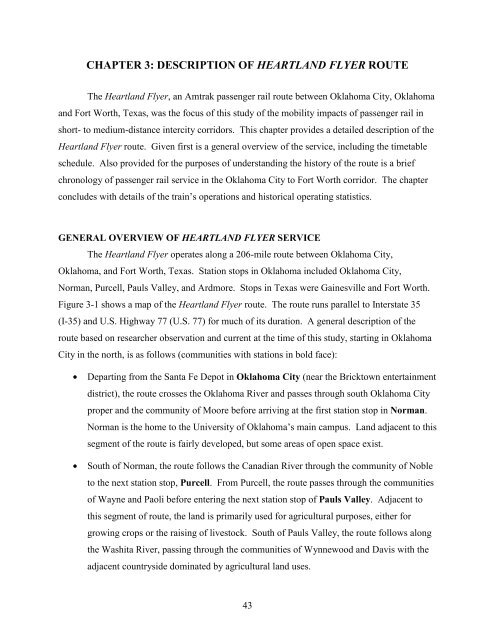Measuring the Benefits of Intercity Passenger Rail: A Study
Measuring the Benefits of Intercity Passenger Rail: A Study
Measuring the Benefits of Intercity Passenger Rail: A Study
Create successful ePaper yourself
Turn your PDF publications into a flip-book with our unique Google optimized e-Paper software.
CHAPTER 3: DESCRIPTION OF HEARTLAND FLYER ROUTE<br />
The Heartland Flyer, an Amtrak passenger rail route between Oklahoma City, Oklahoma<br />
and Fort Worth, Texas, was <strong>the</strong> focus <strong>of</strong> this study <strong>of</strong> <strong>the</strong> mobility impacts <strong>of</strong> passenger rail in<br />
short- to medium-distance intercity corridors. This chapter provides a detailed description <strong>of</strong> <strong>the</strong><br />
Heartland Flyer route. Given first is a general overview <strong>of</strong> <strong>the</strong> service, including <strong>the</strong> timetable<br />
schedule. Also provided for <strong>the</strong> purposes <strong>of</strong> understanding <strong>the</strong> history <strong>of</strong> <strong>the</strong> route is a brief<br />
chronology <strong>of</strong> passenger rail service in <strong>the</strong> Oklahoma City to Fort Worth corridor. The chapter<br />
concludes with details <strong>of</strong> <strong>the</strong> train’s operations and historical operating statistics.<br />
GENERAL OVERVIEW OF HEARTLAND FLYER SERVICE<br />
The Heartland Flyer operates along a 206-mile route between Oklahoma City,<br />
Oklahoma, and Fort Worth, Texas. Station stops in Oklahoma included Oklahoma City,<br />
Norman, Purcell, Pauls Valley, and Ardmore. Stops in Texas were Gainesville and Fort Worth.<br />
Figure 3-1 shows a map <strong>of</strong> <strong>the</strong> Heartland Flyer route. The route runs parallel to Interstate 35<br />
(I-35) and U.S. Highway 77 (U.S. 77) for much <strong>of</strong> its duration. A general description <strong>of</strong> <strong>the</strong><br />
route based on researcher observation and current at <strong>the</strong> time <strong>of</strong> this study, starting in Oklahoma<br />
City in <strong>the</strong> north, is as follows (communities with stations in bold face):<br />
• Departing from <strong>the</strong> Santa Fe Depot in Oklahoma City (near <strong>the</strong> Bricktown entertainment<br />
district), <strong>the</strong> route crosses <strong>the</strong> Oklahoma River and passes through south Oklahoma City<br />
proper and <strong>the</strong> community <strong>of</strong> Moore before arriving at <strong>the</strong> first station stop in Norman.<br />
Norman is <strong>the</strong> home to <strong>the</strong> University <strong>of</strong> Oklahoma’s main campus. Land adjacent to this<br />
segment <strong>of</strong> <strong>the</strong> route is fairly developed, but some areas <strong>of</strong> open space exist.<br />
• South <strong>of</strong> Norman, <strong>the</strong> route follows <strong>the</strong> Canadian River through <strong>the</strong> community <strong>of</strong> Noble<br />
to <strong>the</strong> next station stop, Purcell. From Purcell, <strong>the</strong> route passes through <strong>the</strong> communities<br />
<strong>of</strong> Wayne and Paoli before entering <strong>the</strong> next station stop <strong>of</strong> Pauls Valley. Adjacent to<br />
this segment <strong>of</strong> route, <strong>the</strong> land is primarily used for agricultural purposes, ei<strong>the</strong>r for<br />
growing crops or <strong>the</strong> raising <strong>of</strong> livestock. South <strong>of</strong> Pauls Valley, <strong>the</strong> route follows along<br />
<strong>the</strong> Washita River, passing through <strong>the</strong> communities <strong>of</strong> Wynnewood and Davis with <strong>the</strong><br />
adjacent countryside dominated by agricultural land uses.<br />
43
















